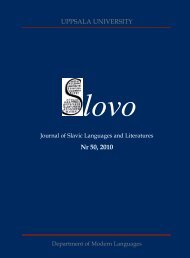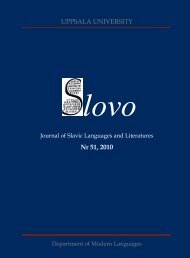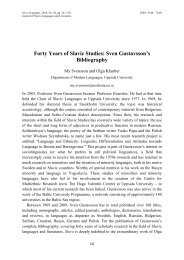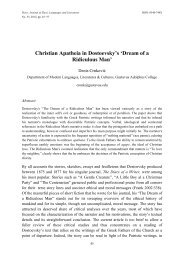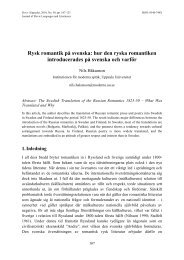Full text PDF - Index of - Uppsala universitet
Full text PDF - Index of - Uppsala universitet
Full text PDF - Index of - Uppsala universitet
Create successful ePaper yourself
Turn your PDF publications into a flip-book with our unique Google optimized e-Paper software.
Margaret Dimitrova<br />
Review: Cynthia Vakareliyska: The Curzon Gospel...<br />
A special chapter in the book is dedicated to the orthography and language <strong>of</strong> the<br />
Curzon Gospel and the peculiarities which distinguish it from the other two Gospel<br />
manuscripts studied in detail by Vakareliyska. In her competent examination <strong>of</strong> the<br />
orthographic and linguistic features <strong>of</strong> the Curzon Gospel, the author correctly discerns<br />
the features <strong>of</strong> the norm(s) followed by the scribe (she assumes that the copyist tried to<br />
imitate closely his Vorlage/antigraph), from the innovations coming from his dialect.<br />
What is noteworthy is that she places her observations on a particular manuscript in<br />
the con<strong>text</strong> <strong>of</strong> much more general issues in mediaeval studies and in linguistics, such<br />
as the factors for the decline <strong>of</strong> the cases in Bulgarian, or the character <strong>of</strong> linguistic<br />
norm and authority in the Middle Ages.<br />
Chapter 5 deals with the specifics <strong>of</strong> the Gospel by Matthew in the Curzon Gospel.<br />
Its investigation provides insights into mediaeval practices <strong>of</strong> compiling <strong>text</strong>s from<br />
more than one source. Vakareliyska observes that the scribe used two different sources<br />
belonging to two different <strong>text</strong>ual traditions <strong>of</strong> the pre-Athonite Slavonic Gospel. She<br />
carefully follows the work <strong>of</strong> the compiler searching for reasonable explanations why<br />
at a certain point he abandoned his initial source and replaced it with another (with<br />
DBC antigraph). Thus, she is right to suspect that the DBC version, in all likelihood,<br />
was the “house” Gospel version (pp. 292) for the scriptorium or monastery where the<br />
scribe worked, but the beginning <strong>of</strong> this “house” codex (with the Gospel by Matthew)<br />
was missing. Therefore, the scribe was forced to look for another source (Vorlage).<br />
Yet, the version <strong>of</strong> Matthew’s Gospel that was available to him seems to not have been<br />
satisfactory. Therefore, when possible, he immediately switched to the DBC version.<br />
In this respect, the analogy that Vakareliyska makes with the technology <strong>of</strong> production<br />
<strong>of</strong> the Serbian 12 th -century Vukan Gospel contributes to the description <strong>of</strong> this process<br />
<strong>of</strong> switch from one Vorlage to another, from one <strong>text</strong>ual version to another in the<br />
Middle Ages. Another important conclusion in this direction is the finding <strong>of</strong><br />
Vakareliyska that for a certain portion <strong>of</strong> the <strong>text</strong>, the scribe “either was consulting a<br />
Greek source and supplying his own translation, or was quoting from memory” (pp.<br />
292).<br />
The chapter “A Tale <strong>of</strong> Two Menologies”, focusing on the calendar <strong>of</strong> the Curzon<br />
Gospel, is a study which has much broader implications than just being a<br />
distinguishing feature <strong>of</strong> a particular Gospel manuscript. It could serve as an excellent<br />
basis for a future book on mediaeval Slavonic calendars and as a reliable methodology<br />
<strong>of</strong> further studies <strong>of</strong> Byzantine-Slavonic symbiosis in the realm <strong>of</strong> calendars and<br />
veneration <strong>of</strong> saints. The analysis is executed in three steps. First, Vakareliyska notices<br />
that the common antigraph <strong>of</strong> the menologies <strong>of</strong> the Banica Gospel and Curzon Gospel<br />
did not originally accompany the DBC <strong>text</strong>ual Gospel version. Second, she discovers,<br />
once again, the use <strong>of</strong> different antigraphs when the menology was compiled and<br />
makes judgment as to which <strong>of</strong> the antigraphs used was preferable and more<br />
authoritative. And third, she provides a detailed juxtaposition <strong>of</strong> the calendar <strong>of</strong> the<br />
101



